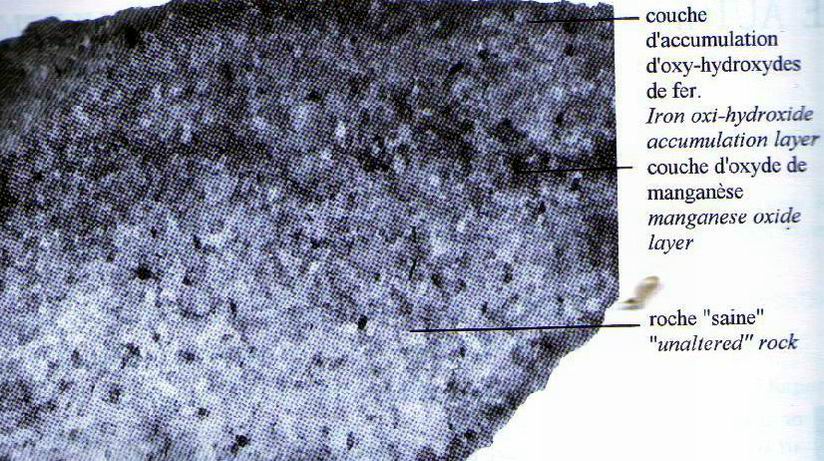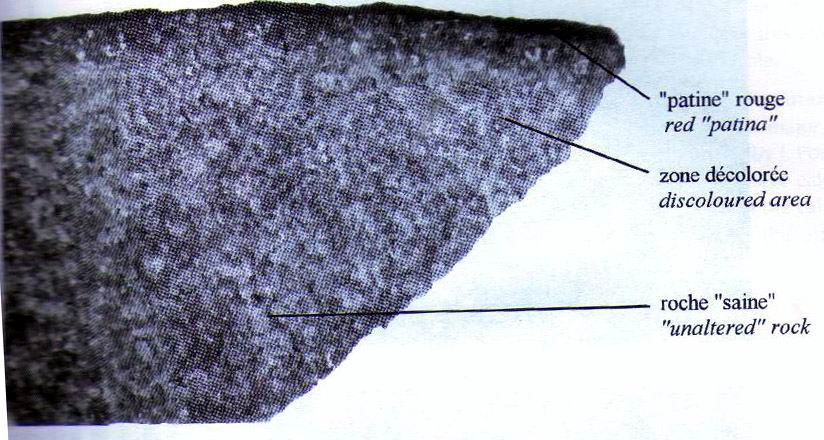
For some decades, many Khamer-style art works of doubtful origin have appeared
on the market, most of which were made in Southeast Asia with materials identical
to the original. We believe that some of these counterfeits may be revealed
by a comparative study of their styles and of the iconography, which professor
Jean Boisslier has so excellently described in his work La Statuaire Khmere
et son evolution. In spite of this source, some assessments of the authenticity
of objects are still difficult to make. For instance, how can counterfeits be
identified when the sculptures are of provincial style, or in the case of images
of divinities whose apparel and ornaments bear no resemblance with anything
known or are stylistically very puzzling. To confirm or dissipate doubts as
to the authenticity of sculpture of this type. It seemed to us necessary torpedoes
an analytical test for the stone on the basis of the specimens we had available.

This analysis was conducted by Mr. Bertrand Duboscq at the Micro-Analysis
Research and Studies Laboratory in Pessac, using as our standard for authenticity
stone samples that had become detached naturally form the Angkor temples. Our
results allow us to draw some conclusion about counterfeits, and we also provide
information about how artificial patinas are produced by counterfeiters. Furthermore,
our results lead us to comment on cleaning processes and thei8r consequences
for stone at Angkor. Naturally, our work is of modest proportions, but we hope
to provide inspiration to researchers with considerable more means than our
own.
One of the constituent rocks of the statuary and temples of Angkor, arkoses,
have a particularly marked alteration fancies, as reflected in the reddish brown
patina that is formed on the surface of the rock and which penetrates some millimeters
in depth, together with a slight, rounded effect on the sculpted surface. The
material's outer features do indeed contribute to assessing the authenticity
of objects that are isolated form their context. However, similar features have
been found on pieces that have been unquestionably identified as being counterfeits.
The purpose of this study is first to describe the major alteration facies of
the arkoses of the Angkor temples by examination of sculpture in the J.M. Beurdeley
collection and fragments that naturally detached themselves form the temple
facades chosen on the basis of their patina or encrustation. Secondly, we study
the "patina" appearing on a counterfeit sculpture.

Two types of analyses were performed:
1) An analysis with a polarizing microscope on thin section specimens. The purpose
of this analysis is (a) to characterize the rock in petrographic terms (major
and accessory minerals, mineralogical phase alteration) and (b) to understand
the process of patina formation. Patina formation was observed on the surface
of the rock by the nature of the deposits reflected in altered surface color,
by their distribution on the rock, and by the various mineral phases as compared
with the internal areas with no patina.
2) An analysis with a scanning electron microscope (SEM) for the purpose of
(a) visualizing the types of mineralogical phase alterations and specifying
the nature of the deposits forming the patina and (b) studying the distribution
of certain minerals inside the rock, from the patina down to the "sound' area.
Our procedure was to produce "X-ray images" which map the distribution of elements
such as iron, manganese, calcium, etc. each white dot of the X-ray images represents
the presence of the element. Consequently, a cluster of dots indicates a concentration
of the element in that spot.
ALTERATION OF ANGKOR ARKOSES
The arkoses used for building the temples of Angkor, and for the statuary, associate
quartzes with alkaline and plagioclase feldspars and white and black micas.
The rock shows undulatory extinction of the quartzes and feldspars. In addition
to these major minerals, there are many accessory minerals too (in order of
their significance: epidote, barite, zircon, sphene). The various minerals are
cemented by clays (kaolinite, chlorite) and late-formed quartzes, associated
with iron oxides and titanium. Calcite sometimes appears as filler in the interstices.
In all cases, alterations of varying degrees may be observed deeper inside the
rock, in the plagioclase feldspars (damouritization, kaloinization) and micas
(chloritization). These alteration processes are sometimes concurrent with individualization
of iron oxides, which can cause the intergranular cement to become ferruginous.
Many of these alterations can be attributed to ancient processes that occurred
before the rock was quarried and sculpted.
THE PATINA
The patina is the result of the combination of physico-chemical and biological
processes.
The physico-chemical processes
The physico-chemical processes produce an accumulation of iron oxides and manganese
oxides on the surface of the rock, sometimes as two superposed strata (1) an
inner black layer of manganese oxide forming a border with the "sound" rock.
The invasion of the surface of the rock partly arises when the clay phases of
the intergranular cement become ferruginous and partly through the accumulation
of iron oxides and hydroxides and of manganese oxides in the int4erstices, which
in some cases they fill up completely.
For these two phenomena to occur, accumulation and ferruginization, the products
of alteration of the minerals deep inside the rock must be drained out to the
surface by water circulating through the rock. A phase during which these products
are recrystalized is also necessary in connection with the cycles of moisture
and drying on the outer surfaces of the sculptures and walls.
In the top layer, the more fragile mineral phases (the feldspars) have undergone
more pronounced alteration together with the formation of iron and manganese
oxides and hydroxides deriving no doubt from more active drainage at the surface
due to rainwater. This activity eliminates the most altered phases producing
the rounded, spotted appearance of the surface.
The biological processes
The role of living organisms (moss, fungi,algae, lichen, bacteria0 in the breakdown
of mineral phases is extremely important. They are active in chemical processes
that dissolve the mineral phases and in mechanical processes. The specimens
examined showed the extent of the mechanical alteration, whereby plant material
gradually penetrates between the rock crystals into the mineral phases progressively
causing them to crack.
Two cases observed were of particular interest. In one case, the plant phases
are closely associated with the iron oxides in the outermost part of the patina.
These oxides appear to hinder the penetration of the plant filaments. Intergranular
cracking is observed and the infrequent porosity in the patina are filled with
plant material. In the other case, the absence of iron oxide deposits on the
surface allows biological degradation processes to occur unhindered causing
significant intergranular cracking that lays bare the mineralogical phases down
through a few tenths of a millimeter. The plant material can also form "encrustation"
of layered organic material.
To sum up, the natural patina formed on the arkoses used for the statuary and
construction of the temples of Angkor is the result of a dual, antagonistic
process of induration and erosion of the rock surfaces. The induration is a
physical-chemical process whereby the iron and manganese oxides accumulate on
the surface layer of the rock. It produces the reddish brown color of the patina
typical of the roofs of the Angkor galleries. Surface erosion arises from a
series of factors, physico-chemical ones (more intense alteration of the mineral
phases on the surface), mechanical ones (ablation of the mineral phases weathered
by surface water) and biological ones (intergranular cracking and mineral phase
breakdown). This produces the rounded, spotted effect on the surface.
COUNTERFEIT PATINAS
Counterfeit patinas are generally obtained by the application of colored mineral
(clays) or organic substances (dyes, resins) to the rock surface. In many cases,
the color and the rounded effect on the surface are not obtained concurrently
and coloring is highly superficial.
We observed a case of a more complex counterfeit patina that was acceptable
on both of the above counts and penetrated to an appreciable depth (around one
millimeter) as exhibited on a fracture. The specimen studied was the head of
a statue acquired in Southeast Asia form a counterfeiter sculpted in an arkose
whose general petrography characteristics were the same as those of the sculpture
and fragments considered ancient previously examined. Examination of a section
of the rock used for making the stature reveals a red "patina" of variable thickness
(1 to 3 mm) but with a very straight boundary as opposed to other patinas. A
slightly discolored area approximately 2 mm thick appears beneath the outer
red layer. The "sound" rock is grayish brown reflecting slight intergranular
coloration by iron oxides.
Thin section examination of the "patina" area shows up a diffuse impregnation
of the mineral grains and the intergranular cement by iron oxides that do not
from clearly defined masses. In the discolored area, almost no iron oxides are
found. Examination of the area with no "patina" reveals the presence of iron
oxides and hydroxides in the form of intergranular deposits associated with
the clays that constitute the rock cement and also in the form of peripheral
deposits of intergranular calcite that is particularly abundant in the arkose.
The X-ray images of the distribution of chemical elements confirm this observation
as to the distribution of iron. It also shows up the absence of calcium in the
patina area and the discolored area immediately beneath it, which in petrography
terms indicates that the intergranular calcite has disappeared.
The relationship between the artificial patina and the disappearance of calcite
prompts us to hypothesize that the "patina" is the result of an acid attack
on the surface of the rock, which selectively breaks down the calcium carbonates
while releasing the iron oxides. Acid treatment of this type leads to: (1) increased
porosity in the rock which can produce an irregular surface with a more granular
surface and (2) uniform coloring of the first, few millimeters subjected to
the acid attack which is the result firstly of iron oxide breakdown over a few
millimeters in depth (the discolored area beneath the red layer) and then of
recrystallization in the external part when the rock surface dries (outer red
layer).
To verify this hypothesis a drop of dilute hydrochloric acid was deposited on
a fragment of "sound" rock and kept in a hot, humid atmosphere for a few hours.
When dried, a red "patina" similar to that observed on the head examined had
formed. This process for producing a counterfeit patina has been successfully
tested on several fragments sampled form other sculptures. Naturally, the result
is variable in terms of coloring depending on the iron oxide and hydroxide content
of the "sound" rock and in all cases is fairly superficial. However, if the
material is highly sensitive to acid attack due to the presence of significant
amounts of calcium carbonate, as was the case with the specimen studied, the
counterfeit patina penetrates deeply and is well developed.
CONCLUSION
The arkoses in the temples and statuary of Angkor present a number of mineralogical
features that sometimes give rise to a characteristic, reddish-brown ferruginous
patina. In this study, we describe a technique for producing a counterfeit patina
which makes use of these petrographic features of arkoses: (1) presence of iron
oxides in the "sound" rock that can be caused to migrate under the effects of
acids and (2) presence in some cases, no doubt the most favorable for producing
counterfeits, of intergranular calcite.
We believe two points regarding conservation in this study deserve to be stressed:
(1) The ferruginous film constituting the patina appears to play a significant
role in protecting the rocks from biological alteration processes. In the absence
of patina, the development of these processes is spectacular. Hence, when cleaning
the surface of the stone, it would seem necessary to try and preserve this natural
protective coating as much a possible.
(2) The existence of arkoses containing intergranular calcite may explain the
major stratified fractures in temples, attributed by J>Pochon, et al. To the
development of expansive calcium sulfate. Calcium sulfate forms from the calcium
carbonate present in the rock and the organic sulfur in humus and animal excreta
(bats, birds). It would be of great interest to verify that there is actually
a correlation between these areas with major fractures and the presence of arkoses
containing intergranular calcite. If the correlation exists detailed petrographic
identification would perhaps be a means for staking out the areas where there
is a major risk of alteration that might require specific restoration treatment.